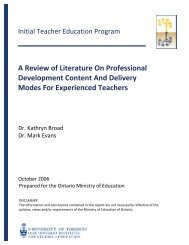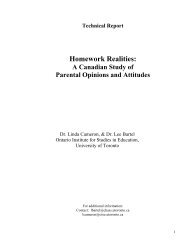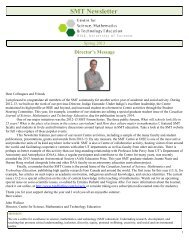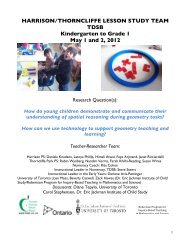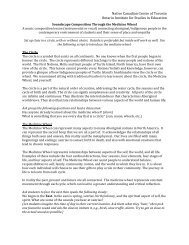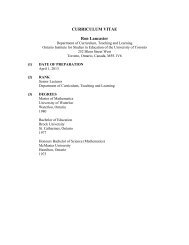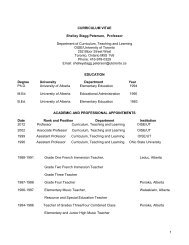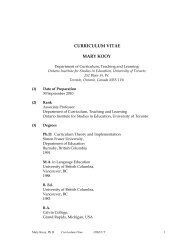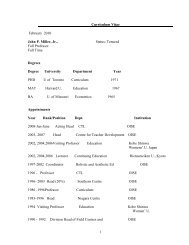The Ontario Curriculum, Grades 9-12 - Ministère de l'éducation ...
The Ontario Curriculum, Grades 9-12 - Ministère de l'éducation ...
The Ontario Curriculum, Grades 9-12 - Ministère de l'éducation ...
Create successful ePaper yourself
Turn your PDF publications into a flip-book with our unique Google optimized e-Paper software.
Sample questions: What provincial or fe<strong>de</strong>ral legislation attempts to protect special<br />
features or sensitive elements of terrestrial or freshwater ecosystems? How could such<br />
legislation be more effective? How have the actions of local wetland-reclamation,<br />
municipal tree-planting, Aboriginal fisheries-management, Great Lakes–rehabilitation,<br />
organic farming, or other groups helped to ensure ecological sustainability? What further<br />
action could such groups take?<br />
B2. Developing Skills of Investigation and Communication<br />
B2. investigate factors related to human activity that affect terrestrial and aquatic ecosystems,<br />
and explain how they affect the sustainability of these ecosystems<br />
B2.1 use appropriate terminology related to sustainable ecosystems, including, but not limited<br />
to: bioaccumulation, biosphere, diversity, ecosystem, equilibrium, sustainability,<br />
sustainable use, protection, and watershed [C]<br />
B2.2 interpret qualitative and quantitative data from undisturbed and disturbed ecosystems<br />
(terrestrial and/or aquatic), communicate the results graphically, and, extrapolating from<br />
the data, explain the importance of biodiversity for all sustainable ecosystems [PR, AI, C]<br />
B2.3 plan and conduct an investigation, involving both inquiry and research, into how a human<br />
activity affects soil composition or soil fertility (e.g., changes to soil composition<br />
resulting from the use of different compostable materials, organic or inorganic fertilizers,<br />
or pestici<strong>de</strong>s), and, extrapolating from the data and information gathered, explain the<br />
impact of this activity on the sustainability of terrestrial ecosystems [IP, PR, AI, C]<br />
B2.4 plan and conduct an investigation, involving both inquiry and research, into how a human<br />
activity affects water quality (e.g., leaching of organic or inorganic fertilizers or<br />
pestici<strong>de</strong>s into water systems, changes to watersheds resulting from <strong>de</strong>forestation or land<br />
<strong>de</strong>velopment, diversion of ground water for industrial uses), and, extrapolating from the<br />
data and information gathered, explain the impact of this activity on the sustainability of<br />
aquatic ecosystems [IP, PR, AI, C]<br />
B2.5 analyse the effect of human activity on the populations of terrestrial and aquatic<br />
ecosystems by interpreting data and generating graphs (e.g., data from Statistics Canada,<br />
Parks Canada, and other websites on: the concentration in water of chemicals from<br />
fertilizer run-off and their effect on the growth of algae; stressors associated with human<br />
use of natural areas, such as trampled vegetation, wildlife mortality from motor vehicles,<br />
and the removal of plants, animals, and/or natural objects; suburban <strong>de</strong>velopments and<br />
their impact on the food supply for animals such as foxes and racoons) [PR, AI, C]<br />
B3. Un<strong>de</strong>rstanding Basic Concepts<br />
B3. <strong>de</strong>monstrate an un<strong>de</strong>rstanding of the dynamic nature of ecosystems, particularly in terms<br />
of ecological balance and the impact of human activity on the sustainability of terrestrial<br />
and aquatic ecosystems<br />
B3.1 compare and contrast biotic and abiotic characteristics of sustainable and unsustainable<br />
terrestrial and aquatic ecosystems<br />
B3.2 <strong>de</strong>scribe the complementary processes of cellular respiration and photosynthesis with<br />
respect to the flow of energy and the cycling of matter within ecosystems (i.e., carbon<br />
dioxi<strong>de</strong> is a by-product of cellular respiration and is used for photosynthesis, which<br />
produces oxygen nee<strong>de</strong>d for cellular respiration), and explain how human activities can<br />
disrupt the balance achieved by these processes (e.g., automobile use increases the<br />
98 Environmental Education, <strong>Gra<strong>de</strong>s</strong> 9−<strong>12</strong>: Scope and Sequence of Expectations, 2011



